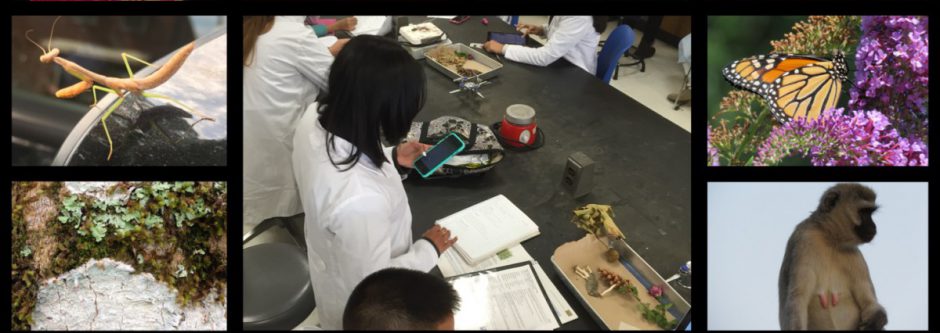| Week 1
Lab I – PDF
How to use a dichotomous key (video)
How to use a dichotomous key (image) |
- List the taxonomic levels from the broadest to the most specific.
- Explain the degree of similarity and difference between organisms classified in a taxonomic table.
- Identify animals and plants through the use of a dichotomous key.
|
|
| Week 2
Lab II – PDF
Prokaryote Concept Map
Virtual Lab |
- Describe the distinguishing features of members of the Domain Bacteria.
- Describe differences between bacteria and cyanobacteria.
- Discuss the distinctive features of each group of algae and protozoans.
- List examples, habitats, reproductive methods, and unique features of representative members of the Kingdom Protista.
|
|
| Week 3
Lab III – PDF
Virtual Lab |
Quiz 1 (Systematics, Taxonomy & Phylogeny, Prokaryotes and Protists) |
- Describe the characteristic features of Kingdom Fungi.
- Explain the division names: Chytridiomycota, Zygomycota, Ascomycota, Basidiomycota and AM Fungi.
- Discuss variations in structure and the sequence of events for sexual reproduction for the major divisions of the Kingdom Fungi.
- Understand the importance of fungi for ecosystems and in human life.
|
|
| Week 4
Lab IV – PDF |
- Describe the process of alternation of generations.
- Explain the criteria for plants classification: conducting tissue, seeds and flowers and distinctive evolutionary features
- Discuss similarities and differences between ferns and bryophytes.
- Describe the life cycles of ferns and their allies.
|
|
| Week 5
Lab V – PDF
Virtual Lab
Virtual Field Trip
Midterm Review Part 1
Midterm Practice I
|
- Describe the life cycle of a pine tree (gymnosperm)
- Describe the life cycle of flowering plants (angiosperms)
- List and give the functions of the principal parts of a flower.
- Describe the structure and function of roots, stems, and leaves.
- Observe and explain characteristics of fresh monocots and eudicots sprouts
|
|
| Week 6
Lab VI – PDF
Ctenophora and Cnidaria
Planaria Feeding |
Quiz 2 (Fungi & Plants) |
- Explain and discuss animal classification (levels of organization, body symmetry, coelom, protostomes, deuterostomes)
- Describe the distinguishing features of members of the phylum Porifera and the phylum Cnidaria. Describe the body forms of cnidarians. Compare the feeding methods of sponges and jellyfish. Observe the feeding behavior of live hydra capturing live water fleas (daphnia; crustaceans).
- Describe the general morphology of flatworms (phylum Platyhelminthes). Observe the morphology and behavior of live Planaria
|
|
| Week 7
Lab VII – PDF
Live Rotifers
Earthworm Dissection
Annelids (Shape of Life)
Clam Dissection
Molluscs (Shape of Life) |
- Describe the general morphology, major classes and advanced characteristics of roundworms (phylum Nematoda) and rotifers (phylum Rotifera). Observe the behavior of live rotifers.
- Describe the general morphology of organisms of phylum Annelida and phylum Mollusca. Dissect preserved earthworms and bivalves (clams)
|
|
| Week 8
Lab VIII – PDF
Grasshopper Observation
Terrestrial and Marine Arthropods (Shape of Life)
Sea Star Dissection
Echinoderms (Shape of Life)
Frog Dissection
Chordates (Shape of Life)
Midterm Review Part 2
Midterm Practice IIa
Midterm Practice IIb
|
- Describe the general morphology, characteristics and major classes of phylum Arthropoda. Describe modifications of the exoskeleton and paired appendages of arthropods. Observe preserved insect specimens (grasshoppers)
- Describe the morphology, characteristics of the phylum Echinodermata. Dissect preserved sea stars (if available).
- Describe the morphology, characteristics of the phylum Chordata. Dissect preserved frogs
|
|
| Week 9
Lab IX – PDF
Virtual Lab
A Quick Tour of Tissues |
Uniform Midterm Practical + Quiz 3 (Animals) |
- Describe the general properties of tissues versus single cells
- Describe the characteristics of epithelial, connective, muscular and nervous tissues
- Describe the organization of the skin as an organ made of several tissues working together
|
|
| Week 10
Labs X & XI – PDF
Fetal Pig Dissection |
- Understand the classification of the pig as a mammal; name the unique mammalian characteristics represented by the fetal pig.
- Define all the anatomical terminology, planes and structures
- Dissect and identify the components of the digestive and respiratory systems
|
|
| Week 11 |
- Identify, observe and dissect and the heart and pericardium; identify major blood vessels.
- Define, identify, and describe components of the female and male urogenital system of the fetal pig.
|
|
| Week 12
Lab XII – PDF
Urinalysis
Urinalysis Results |
Quiz 4 (Vertebrate Anatomy: Tissues, Organs and Organ Systems) |
- Define homeostasis and why it is an important characteristic of every life form
- Describe the structure and function of the human lungs, liver and kidneys and their role in the maintenance of homeostasis
- Describe the process of urine formation in the human kidney
- Explain and discuss negative and positive feedback mechanisms.
- Test urine samples, discuss and explain results
|
|
| Week 13
Lab XIII – PDF
Sheep Brain Dissection Video
Sheep Brain Practice |
- Define and describe the components of the central and peripheral nervous systems
- Identify the components and basic function of the sheep brain and their human counterparts on the models available
- Describe the structure of the spinal cord and the mechanism underlying reflexes
|
|
| Week 14
Lab XIV – PDF |
Quiz 5 (Physiology: Homeostasis, Organ Functions and Nervous System) |
- Asexual and Sexual Reproduction in Animals
- Human male and female reproductive systems and cycles
- Describe the main steps in the embryological development of vertebrates
- Identify the various stages in the developmental models provided
Review for Final Practicum |
|
| Week 15 |
Uniform Final: Fetal Pig/Brain Practicum
|
 available here. Students should read the scheduled lab exercises before coming to class.
available here. Students should read the scheduled lab exercises before coming to class.




